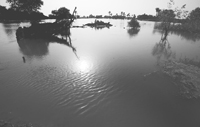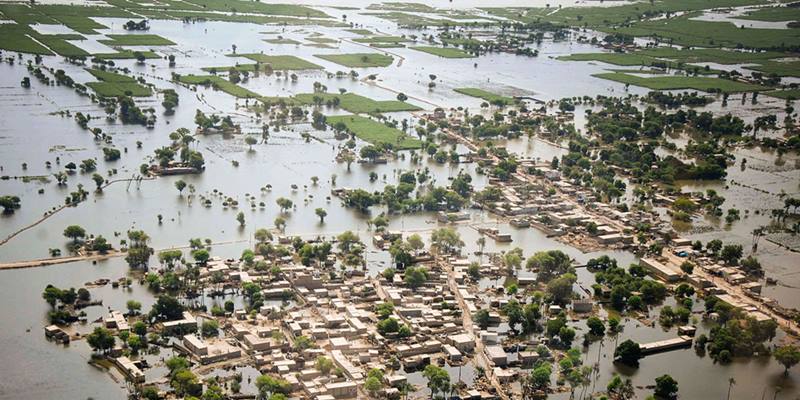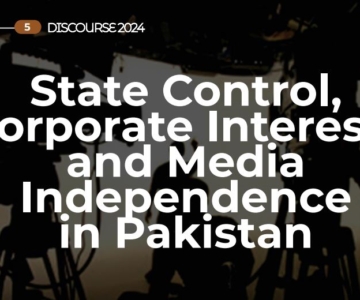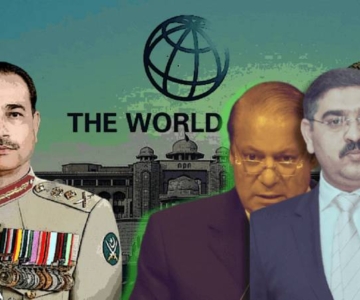My latest piece on Pakistan’s incredible calamity and its after-effects
Pakistan’s devastating floods have opened up a Pandora’s Box of governance dysfunctions and historical distortions that have plagued the polity since independence. It remains to be seen what will be the outcome of the greatest calamity in our recent history. Various estimates show that the floods have affected 18-20 million people. The death toll has crossed the figure of 2000 while 2 million houses have been damaged or destroyed. Floodwaters are receding in many areas, and though there are concerns about standing water that remains in Punjab and other areas, the worst of the current flooding is taking place in Sindh.
The disaster is still not over but the fissures within Pakistan have started to erupt and once again proving how vulnerable the state is and how fractured the Pakistani society has become. Five key crises have emerged, some old and some new. However, they point to the fact that our continuous refusal to address structural problems remains a key challenge.
Martial state syndrome: Pakistan’s history is an uninterrupted tale of direct and indirect military rule and centralisation. Each time there is a crisis there is a need to resort to the de facto, real governance paradigm: the military rule. Therefore, Altaf Hussain of the Muttahida Qaumi Movement (MQM) and Imran Khan of the Pakistan Tehreek-e-Insaaf (PTI) are not saying anything new. The perennial search for a Messiah, rooted in the religious ideology that the state and education system have cultivated, is back in full force. This time the media and other discordant voices are calling for another phase of direct military rule.
It remains unclear where this goal will be achieved in the short term. The odds are against a direct military intervention given the army’s involvement in war against militancy and extremism in the country. Similarly, the Generals may not be very keen to take charge of a country deep in crisis. Yet, the calls for regime change are meaningful. There is another dimension to this crisis and that relates to the Superior Courts who have now formally entered the power-wielding quartet (comprising the parliament, army, the judiciary and the media).
There have also been calls for a Bangladesh model that empowers the judges to take the reins of power as honest and impartial caretakers until the next election. Given that the elections are at least two and a half years away, this may not be a feasible idea.
Economic instability: The cyclical patterns of growth and income generation are also an established pattern in the country. The recent disaster will lead to massive downturn. The ministry of finance and its advisers have predicted a zero percent growth rate and 25 percent inflation rate. This would spell another disaster for food security and endemic problem of poverty.
It is unclear how the government, the incumbent or the future dispensation will be able to arrest the economic decline. The international community, it appears is not going to bail out Pakistan after the relief phase is over. Loans worth 3.5 billion dollars have been announced by the international finance institutions but the debt servicing needs are going to further exacerbate the economy and leave limited fiscal space for the gigantic task of reconstruction that may involve 10-20 billion dollars. A damage needs assessment is being carried out by IFIs and the government and only then the picture will be clear.
At this crucial juncture of Pakistan’s history it is clear that political instability is going to fuel economic uncertainty and, therefore, going to spur an economic collapse unless of course the quartet appreciates the gravity of the challenges and attempts to induce political stability by not attempting to sabotage the current quasi-civilian order.
However, the chances of such a consensus are remote and limited as various power players are treating this situation as an opportunity to leverage their interests and stakes, thereby rendering the primary task of dealing with the disaster meaningless. Therefore, attaining economic stability is a distant dream unless of course the parameters of political game are redefined.
Collapse of civilian administration: Floods have only exposed what analysts had been saying for a long time. Pakistan’s governance institutions in the civilian domain have lost their efficacy and relevance. Even after a month of flooding and wide-scale devastation, the civilian machinery has been unable to rise to the occasion. The national and provincial disaster management authorities are being rescued by the donors for the inherent capacity of the state to plan and execute emergency measures seems to have disappeared altogether.
Pakistan’s inability to undertake any meaningful civil service reform in the last four decades means that millions of under-paid, unaccountable and disenchanted public sector employees are not geared towards service delivery let alone dealing with disasters.
The NDMA Ordinance has lapsed since long. The new commission to be formed has still not been put into place and the provinces are more interested in scoring points with the Centre rather than coordinating relief and rehabilitation plans and delivery.
Reform is not a short term process, therefore, the situation is not going to change in the next one year or so. But the reform process has to begin now. There was never an urgent need for introducing reforms than this particular moment. First and foremost is the need to revive the local government system that had been made dysfunctional by the elected governments in 2008. This unwise policy choice, despite its legitimacy, is now there to haunt the state as well as the elected officials as they have no credible means of ensuring delivery of aid other than relying on the unelected and corrupt machinery of the revenue departments or to move towards the non governmental networks.
Furthermore, it is also imperative to set the right structures at the provincial and district levels to ensure that citizen voice and accountability are kept in view in the post-relief phase. The chances on this front are not too promising as there are complaints of political partisanship, hijacking of aid and ignoring the marginalised.
Disaffection and militancy: Contrary to several claims of the optimistic analysts, the relief efforts by the faith-based (and in some cases banned) organisations is not a positive trend. In a country, which is already fractured and split on the issue of religious militancy, this is a recipe for further unrest. Take the case of Swat where pundits had observed the land struggles as a major cause for militancy. The floods have displaced the poor and once the situation returns to normalcy the land rights of tenants or farm workers will come into the spotlight once again.
In the absence of dispute resolution or complaints redress mechanisms this will be an ideal playground for the jihadis to motivate the poor and invite them to their ranks or seek their political support. The situation in Southern Punjab will be similar as well due to the well-organised and entrenched networks of militancy.
It should not be forgotten that the suspension of the military operation for weeks may have given the much-needed opportunity to the militant groups to reorganise. The recent wave of terror in Khyber Pakhtunkhwa and recently in Lahore indicates that the terrorists are back in action and would not mind hurting the state when it is embroiled in disaster-management, political squabbling and divided along several ideological lines.
Even if we discount the prospect of more recruitment of militants, the influx of several displaced and dispossessed in the urban centres will be a major boon for the criminal networks operating in the cities. The nexus between these elements and the militant groups has also been observed. Though we lack accurate data in this context, but anecdotal evidence and the incidence of bank robberies during the rise of Taliban in 2008-2009 is a rough guide.
Popular disaffection with the state has been a theme well-played by the media circus of Pakistan. Iniquitous land relations in Sindh and other rural areas, heavily hit by the floods will become a major source of public disenchantment with the state agencies. This is a situation that Pakistan cannot afford as the country needs to focus on the issues of terrorism and rebuilding the economy. How the policymakers handle this is also an area that public has limited knowledge about. In fact, whether the civilian governments are also aware of the ‘national security’ game plan is also an unknown.
Weakened constitutionalism and federalism: The 18th Amendment had provided a sound framework for Pakistan to exist and prosper as a functional federation. Its implementation is still a pending task and seems compounded by several factors. First, the Supreme Court’s hearing of the cases against the Amendment and the recent injunction suspends the constitutional provisions in effect. Had these provisions been inserted by a dictator, this was not an alarming issue. But when a new framework for governance, approved with consensus of the four provinces and two chambers, is called into question by a bench of appointed judges (with competing claims of popular legitimacy) is a worrying signal. We cannot expound further as the case is subjudice and the final verdict will make the situation clearer.
The second issue is that of the emerging resource crunch given the provinces’ dire need for reconstruction. The tensions are going to affect already tenuous federal arrangements. If the Centre raises funds through external debts, then it gets a policy lever to exert on the provinces, which rightly feel empowered after the 18th Amendment.
Finally, the rumours of extra-constitutional arrangements (national government, Bangladesh model or a martial law) imply that the implementation or even the fate of the 18th Amendment may now be uncertain. This is nothing short of an upheaval as Balochistan is already harbouring separatist sentiments and Khyber Pakhtunkhwa is facing the wrath of those who want to set up real Islamic Emirate[s]. If the current party in power at the Centre is booted out then alienation of Sindh cannot be ruled out. How will the country and its federal order painfully corrected in the recent years survive? These are alarming prospects.
In conclusion, Pakistan’s ruling elites fond of palace intrigues and power maximisation tricks must realise that this may be the last chance of saving the country, as we know it. First, the democratic forces must stick together to fight the prospect of authoritarianism, fascism and media-propelled right-wing revolution in the middle classes. Second, the focus should be on the economy for post-relief phase requires Pakistan to recover from this mammoth shock. Internal resource mobilisation and cutting down on current expenditure (including deferring payments on debts) should be a clear agenda.
Thirdly, the local government system should be strengthened at once and local capacities be enhanced to deal with the mayhem in 80 districts. Finally, the Pakistan army should also remember its core mandate of protecting Pakistan from its enemies — this time the enemy lies within. It is heartening to know that there is realisation of this imperative in the top command but the distractions caused by an opportunity must be ruthlessly dealt with. Pakistan cannot afford political or economic instability. This time the spiral of uncertainty might just target the state itself.
The writer is a policy adviser, writer and editor based in Lahore. He blogs at www.razarumi.com. Email: razarumi@gmail.com



